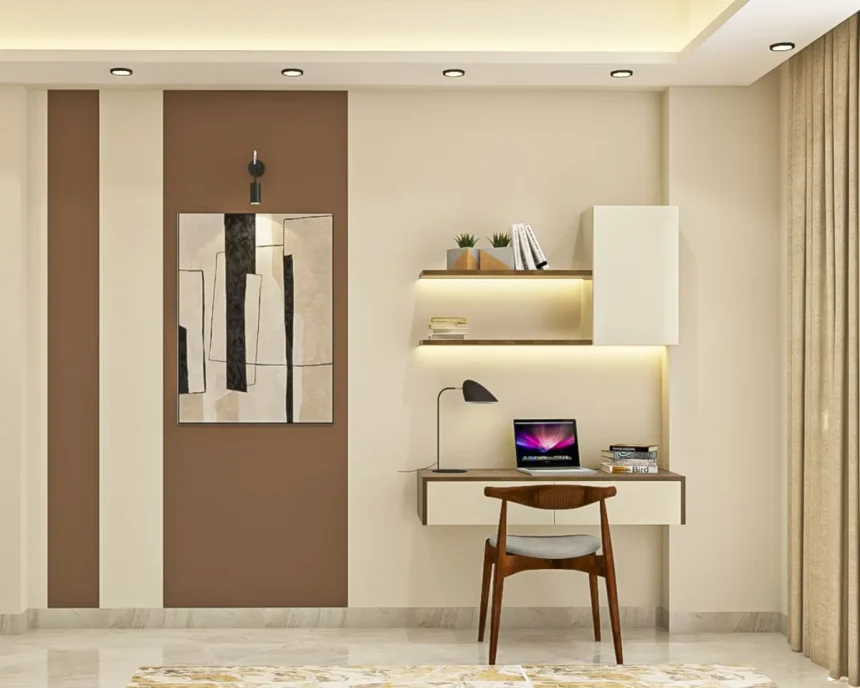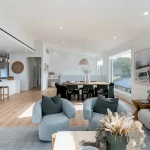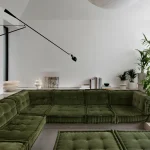Key Elements of a Functional Study Room
Creating a functional study room starts with three main elements: lighting, ergonomic furniture, and color schemes. Good lighting is essential—natural light helps reduce eye strain and lifts your mood, while task lighting like desk lamps keeps your focus sharp during late-night work. Next, ergonomic furniture makes a big difference. A comfortable chair and a properly sized desk support good posture, preventing aches and helping you stay productive longer. Finally, color schemes affect how well you concentrate. Soft, neutral colors like light blues or greens are calming, while bright colors can be distracting. Using these key elements together ensures your study space helps you stay focused and comfortable.
Study Room Design Ideas for Every Space
Designing a study room that fits your space and lifestyle is key for productivity. Here are some ideas to help you make the most of any area:
Minimalist Study Rooms for Small Spaces
- Keep furniture simple and functional with clean lines.
- Use foldable desks or wall-mounted tables to save room.
- Stick to neutral colors and avoid clutter to create a calm, focused environment.
Kid-Friendly Study Corners
- Choose colorful, sturdy furniture that grows with your child.
- Add storage bins for books and supplies within easy reach.
- Use fun decor like educational posters to make learning inviting.
Modern and Tech-Savvy Workspaces
- Opt for desks with built-in charging stations and cable management.
- Incorporate LED task lighting to reduce eye strain.
- Use smart organizers or wireless accessories to keep the space tidy.
Cozy and Inviting Study Nooks
- Add soft seating like cushions or a small armchair.
- Use warm lighting and textiles to create a comfortable vibe.
- Place the nook near a window to enjoy natural light and fresh air.
Collaborative Study Zones for Families
- Use large tables to encourage group work or family projects.
- Include multiple seating options for kids and adults.
- Add whiteboards or chalkboards for brainstorming and planning.
No matter the size or purpose, these study space ideas can help you design a practical and motivating environment in your home.
Storage and Organization Tips
Keeping your study room tidy is key to staying focused. A clutter-free workspace reduces distractions and helps you get more done. Start by regularly decluttering—toss or donate anything you don’t need.
Decluttering for Focus
- Clear your desk at the end of each day.
- Keep only essential items within reach.
- Use a daily or weekly routine to stay on top of papers and supplies.
Creative Storage Solutions
- Use vertical storage like wall shelves or pegboards to save floor space.
- Storage bins and drawer organizers keep small items neat.
- Consider multipurpose furniture, like desks with built-in shelves or storage compartments.
- Label containers for easy access and faster cleanup.
Organizing smartly in your study space makes it easier to focus, keeps your materials handy, and creates a calm environment ideal for productivity.
Personalizing Your Study Room Adding Greenery and Natural Elements Unique Decor Ideas
Making your study room feel personal can boost your motivation and comfort. Start by adding greenery—small potted plants or easy-to-care-for succulents bring in natural elements that improve air quality and reduce stress. A bit of nature equals a calm, fresh vibe that helps focus.
For unique decor ideas, consider items that inspire you, like framed prints, motivational quotes, or a favorite artwork. You can also add texture with cozy rugs or cushions to make the space inviting but not distracting. Use personalized organizers or colorful trays to keep essentials handy and reflect your style.
Remember, your study room should feel like your own space—clear and uncluttered but with touches that keep you engaged. For more home decor inspiration, check out creative accents like mushroom home decor that blend well with any design style.
Budget-Friendly Study Room Makeovers
Creating a functional and inviting study room doesn’t have to break the bank. With a few smart choices, you can refresh your study space without spending a fortune. Here are some budget-friendly ideas to makeover your study room:
- Repurpose what you have: Use old furniture in a new way. A sturdy dining chair can become an ergonomic study seat with a cushion. An unused table can serve as your study desk.
- DIY storage solutions: Instead of buying expensive shelves, try floating wall shelves or stackable bins. This keeps your study space clutter-free and organized.
- Add lighting upgrades on a budget: Swap out harsh bulbs for soft LED lights or add affordable desk lamps to improve task lighting.
- Paint and color tweaks: A fresh coat of paint or even removable wallpaper can shift your room’s vibe to boost focus. Stick to calming colors like soft greens or blues.
- Use natural elements: Adding a small plant or simple greenery lifts the mood and doesn’t cost much.
- Minimal decor: Keep décor simple but meaningful to avoid distractions. You can find budget-friendly productivity decor that matches your style.
- Shop smart for ergonomic furniture: Look for sales or secondhand options to get proper chairs and study tables without overspending.
By using these budget-friendly tips, you can create a clutter-free, comfy study room that suits your needs and helps you stay focused. For more small space ideas, check out our guide on small powder room design ideas that share smart use of limited space and style.
Common Mistakes to Avoid
When designing your study room, watch out for these common pitfalls to keep your space productive and comfortable:
-
Ignoring Lighting Needs
Poor lighting kills focus. Avoid relying only on overhead lights—combine natural light with task lighting to reduce eye strain. -
Choosing Uncomfortable Furniture
Skipping ergonomic study furniture can lead to discomfort and poor posture. Invest in chairs and desks that support long study sessions. -
Overcrowding the Space
Too much stuff creates a cluttered workspace. Keep only essentials to maintain a clutter-free environment. -
Neglecting Personal Touches
A bare room can feel cold and uninspiring. Add simple decor or greenery to make the study space inviting and motivating. -
Using Distracting Colors
Bright or flashy colors might break focus. Opt for calm, neutral colors that encourage concentration. -
Ignoring Storage Options
Without good storage, papers and supplies pile up fast. Use creative storage solutions to stay organized.
Avoiding these mistakes will help you create a study room that fits your needs and boosts productivity every day.
Aura’s Top Product Recommendations
When setting up your study room design, having the right products can make all the difference. Here are Aura’s top picks to help you create a functional, comfortable, and inspiring study space that fits well in American homes.
Ergonomic Study Furniture
- Adjustable Office Chairs: Choose chairs with lumbar support and adjustable height to keep you comfortable during long study sessions.
- Modern Study Tables: Look for tables that offer enough surface area without overwhelming small spaces — ideal for minimalist workspaces.
Lighting Essentials
- LED Desk Lamps with Adjustable Brightness: Good task lighting reduces eye strain and helps maintain focus, especially during late hours.
- Natural Light Enhancers: Sheer curtains or light-filtering blinds boost natural light, creating an inviting, productivity-friendly environment.
Storage and Organization
- Stackable Storage Bins: These are perfect for keeping supplies organized without cluttering your desk.
- Floating Shelves: Save floor space and add a modern touch while keeping books and study materials accessible.
Decor and Personalization
- Low-Maintenance Plants: Add greenery with succulents or air plants to promote calm and improve air quality.
- Inspiring Wall Art and Bulletin Boards: Personal touches like motivational prints or organized cork boards keep you on track and motivated.
Kid-Friendly Study Solutions
- Colorful Adjustable Desks: Perfect for growing kids, these adapt as they get taller and add a fun element to the study space.
- Soft Seating Options: Bean bags or cushioned chairs make study corners cozy and inviting for children.
Budget-Friendly Options
- Multi-Use Furniture: Desks with built-in storage or foldable tables maximize utility without breaking the bank.
- Affordable Desk Organizers: Simple trays and bins from major retailers help declutter without expensive upgrades.
These recommendations mesh well with popular home office designs and small study room tips across the U.S., helping you build a study room that works for your lifestyle and space.








